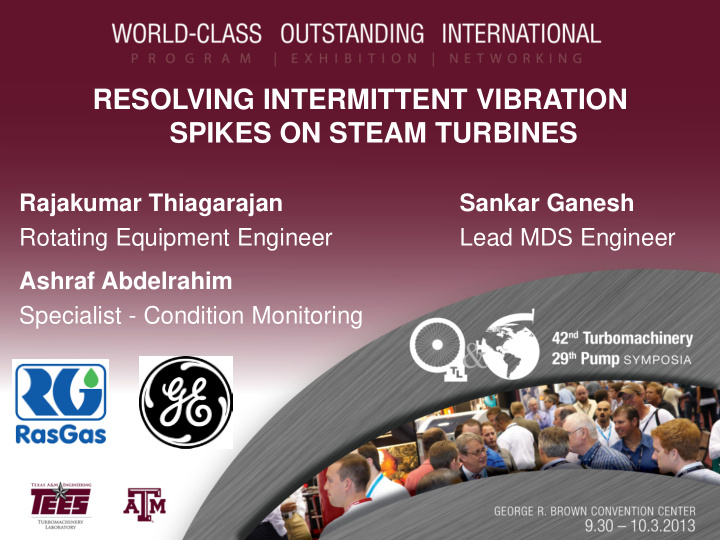



RESOLVING INTERMITTENT VIBRATION SPIKES ON STEAM TURBINES Rajakumar Thiagarajan Sankar Ganesh Rotating Equipment Engineer Lead MDS Engineer Ashraf Abdelrahim Specialist - Condition Monitoring
Contents • Background • Machine description • Data analysis • Initial Analysis & Recommendations • Machine Inspection results • Subsequent Mechanical Failure Analysis • Conclusions • Lessons Learned
Background Six Fresh Cooling Water Pumps: 4 Steam Turbines and 2 Motor driven pumps Critical pumps in LNG production Intermittent vibration spikes - Proactive detection on three steam turbines using expert systems The condition deteriorated and sporadic steam turbine trip. Plant vulnerable to production loss Sea Water Out FCW Pump A - F Sea Water Tank Pump A - F In Make up Schematic Diagram of Fresh Cooling Water System
Machine Description PUMP ST Turbine Type: Back pressure (5 stage) Bearings: Tilting pad Seals: Mechanical Labyrinth Coupling: Diaphragm Power: 3840KW Speed: 3602 RPM
Data Analysis Process parameters Turbine vibration Green plot – Vibration Black, White, Red & Blue plots – Process parameters Overall Vibration vs. Process data Increasing Vibration Trend & High vibration Trip No correlation with the process parameters
Data Analysis Cont’d.. Polar Plot – 1X Amplitude & Phase Angle Turbine NDE-X Turbine NDE-Y Turbine DE-Y Turbine DE-X Abnormal Behavior – Significant Phase Angle Change During Steady State (All Over 360 0 )
Data Analysis Cont’d.. Direct Orbit Review During Vibration Excursion Turbine DE Turbine NDE Flattened Orbit Truncated Time waveform Flat Orbit & Truncated Time Waveform due to Rub
Data Analysis Cont’d.. Direct Orbit Overlay – Comparison of Low & High Vibration Amplitudes Turbine DE Turbine NDE Direct Orbit Becomes circular when the vibration is at maximum Orange plot – when vibration is at minimum Blue plot – when vibration is at maximum Significant change in the Orbit Shape & Amplitude (Change in Balance Condition Due to Thermal Bow)
Data Analysis Cont’d.. Thermal Bow Effect of Rub High Spot α 0 α 0 Rubbing Spot mr Ω 2 mr Ω 2 Ω Ω 1X Orbit Heavy Spot Seal A New High Spot Effective α 0 and Rubbing Unbalance α 0 Location mr Ω 2 mr Ω 2 Ω Ω Increased 1X Orbit 1X Orbit
Data Analysis Cont’d.. Vibration Trend and Polar Plot – Reviewed for 2 nd Steam Turbine Intermittent vibration spikes Phase angle change all through 360 degree Similar Behavior - Intermittent vibration Amplitude & Change in Phase Angle
Data Analysis Cont’d.. Vibration Trend and Polar Plot – Reviewed for 3 rd Steam Turbine Intermittent vibration spikes Phase angle change all through 360 degree Similar Behavior But Less Severity - Intermittent vibration Amplitude & Change in Phase Angle
Initial Analysis & Recommendations: Expert Analysts at site concluded the Rubbing Issue is most likely due to Carbonized oil buildup in the oil deflector / seal area. Recommended Action Items: Inspect oil/steam seal areas for rubbing marks due to deposit built-up / carbonized oil.
Machine Inspection Results Oil Seal Area at Non Drive End Bearing of 1 st Turbine Carbonized deposits at NDE seal area Rubbing Marks on the shaft Rubbing Marks at the seal area due to oil carbonization is evidenced.
Machine Inspection Results Cont’d.. Rotor Internals of 1 st Turbine No abnormalities noticed on the Rotor internal components.
Machine Inspection Results Cont’d.. Oil Seal Area at Non Drive End Bearing of 2 nd & 3 rd Turbine Seal Area of 2 nd Turbine Seal Area of 3 rd Turbine Oil Carbonization deposits and Rubbing Marks at the seal area Based on the inspection results of 1 st Turbine, no internal checks carried out for the 2 nd & 3 rd Machines
Subsequent Mechanical Failure Analysis Oil leak and migration to steam end Sealing Air Design issue pressure low LO Supply Breather Pressure high clogging Carbonization Outside Operating condition Ejector poor Gland fins performance clearance high Heavy Steam Leak from steam gland
Conclusions Primary Causes: Low seal air pressure - Oil leakage, migration at steam gland Contributed Causes: Breather clogging - Oil leakage due to vapor accumulation and high lube oil pressure inside the bearing housing Design issues Back pressure on the common return header - Wrong elevation of breather on the Gearbox drain line Oil shelter in close vicinity to the steam gland Action Items: Installed Pressure Gauge Breather cleaning task - Equipment Strategy. Modify the Breather elevation
Lessons Learned Reduced Maintenance Cost and Down Time Prognostic approach on the issues and accurate analysis through experts helped early detection of machine malfunctions. Findings on one steam turbine assisted to minimize the maintenance activities on other two steam turbines. Presence of online diagnostic system helped to plan the machine shutdown for the maintenance without impact on the production. Design issues – A lesson for future projects. Absence of seal air pressure monitoring Close vicinity of oil seal and steam gland Wrong elevation of breather location on the Gearbox
Recommend
More recommend